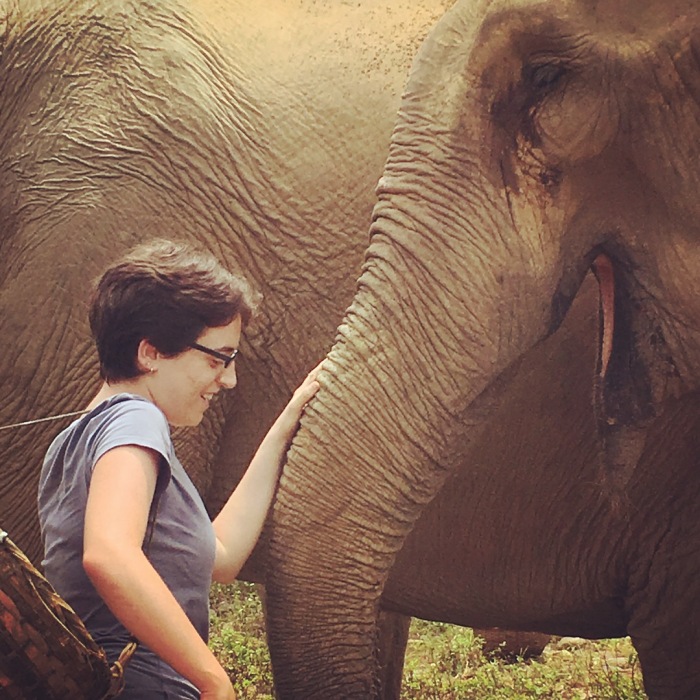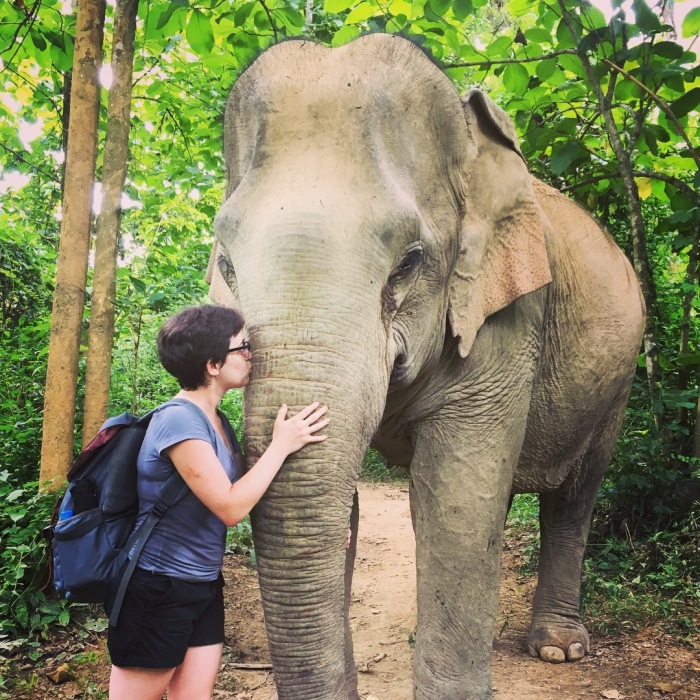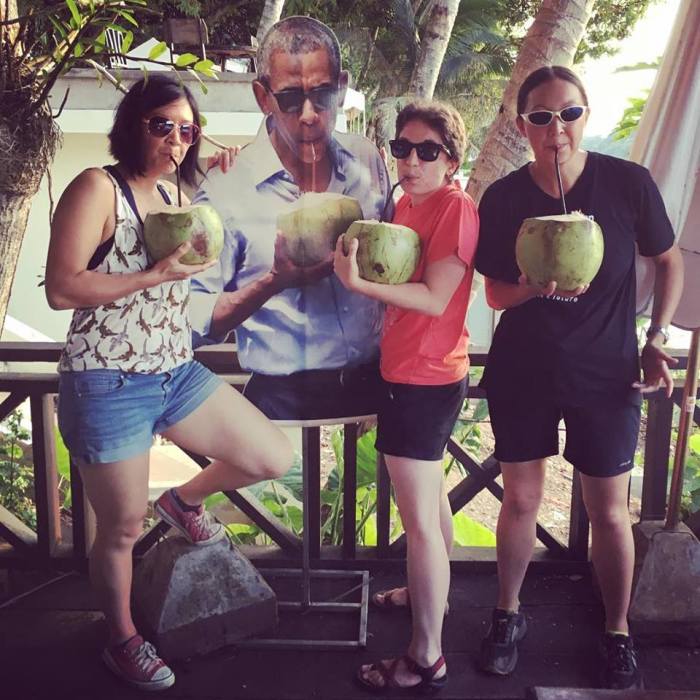If you had told me when I started this journey that I would find myself dancing the Chicken Dance and the Macarena in a classroom atop a mountain shrouded in monsoon clouds, I’m not sure I would have believed you, but that is exactly where I found myself yesterday.
I have been attempting to use any free time outside of the clinical setting to have experiences that can better inform my practice. While hiking, exploring, and trekking with elephants has had more of an indirect corollary to my understanding of the lived experiences of the patients, families, and staff I have been working with during my time here in Laos, yesterday’s adventure provided me with a much greater understanding of the Lao educational system, how many children learn and play here, and offered one explanation of why certain thought processes and cultural norms are common amongst patients, families, and staff.
Yesterday was Lao Women’s Day and many of the staff, myself included, had the day off from the hospital. As it was a weekday, I took the opportunity to visit a local school with a friend who is also a hospital volunteer. Our day volunteering as English teachers was fascinating and, in some ways, troubling.
Laos is not a literate country. Today, there are few books and it is quite common for people not to know how to read and write. Illiteracy is even more common amongst adults and for many families who I work with at the hospital, it is often that the patient or the patient and siblings are the only members of the family who can read and write. Approximately a decade ago, a publisher from Boston visited Laos and, shocked by the complete lack of books, started a not-for-profit, Lao-owned business to publish books and teach reading and writing in Lao and English to interested children and adults. The business continues to operate, selling books and holding informal conversation classes out of a storefront in the tourist area of Luang Prabang as well as operating a local school. Both my friend and I had heard about the organization and wanted to visit the school as a way to see what some children may be experiencing in the Lao educational system.
We met at the storefront and were joined by the founder who continues to teach the older children at the school as well as to be one of the shepherds of the daily tourist volunteers. My friend, the founder, another tourist volunteer, and I climbed into the back of a tuk-tuk truck and began the half-hour drive through the monsoon to the school. As we forded roads that looked like rivers, the founder told us more about the mission of the school and their philosophy. Hearing him talk, I was quite excited to visit the school. He spoke about wanting to change the educational system here in Laos from rote memorization and recitation to one that nurtured creative thought and problem-solving and increased children’s skills in literacy, English, and mathematics. It sounded like a very noble and inspiring learning environment and, having been a preschool and kindergarten teacher prior to entering child life, I was greatly looking forward to not only seeing, but offering my time to help support the mission. As we climbed out of the tuk-tuk truck and slogged up the hill to the school, navigating flowing water and mud to begin the day, it slowly became clear that, while what the founder had shared with us was a grand vision, the school itself was a bit different from what was advertised.
The three of us met with a school employee whose job it was to accompany us throughout the day. We met with the group of oldest children first, who ranged in age from 16 to 25 years old and who live at the school, studying math, English, and receiving training to become teachers. We sat with them on the floor, were asked a series of pre-written questions in English, and then handed a stack of flashcards which became a repetitive theme for the day. The flashcards contained a random mix of pictures of regionally appropriate fruit and vegetables, random animals, and dinosaurs accompanied by an English label. We were instructed to “play a game” by laying the cards face up in front of us and asking questions about them, such as “where is the rhino?” or “what card has the color yellow?” The students would then point to or tap whichever flash card they thought I was referring to and, if correct, gain possession of that card. We were given the same flashcards and the same task with children in every classroom in the upper school, regardless of developmental level. When my fellow volunteer and I would try to mix it up as the day went on by playing games with the cards, such as a bizarre version of Go Fish or Memory, or handed out the cards to the children and had them choose from their hands in a silly, made-up game of “what goes in the soup?”, we were immediately told to stop and go back to the original task.
While the flashcards disappeared when we visited the lower school and worked with children aged 3-5 years old in three other classrooms, we were also given very repetitive assignments that lacked opportunities for creativity or open-ended play. In every classroom, we were first made to stand in a circle and ask the children to point to different parts of their bodies by asking questions like, “where is your nose?” We were then separated into groups and given a book to show to the children instead of reading, instructed to describe what the pictures were on the page. When I attempted to sing “Head, Shoulders, Knees, and Toes” with the children or ask open-ended questions about the pictures, I was immediately hushed.
There were other moments in the day that I found troubling. I was at first elated to learn that the children in both schools are given frequent music and dance movement breaks, only to learn that each music and dance movement break was incredibly choreographed. Being in a room with close to fifty children aged 6-15 years dancing the Chicken Dance, the Macarena, and another dance with which I am not familiar in nearly perfect unison as a break from their incredibly scripted, rote memorization-style lessons was a bit unsettling.
The children did have about half an hour of recess time, spent indoors due to monsoon season. This half-hour stretch of time was the only point I saw any creative, open-ended play as children bounced from classroom to classroom, skipping rope, talking, and playing and building with a set of straws and connectors, a new toy at the school. My relief at this one moment of creativity and problem solving was quickly dashed when the founder, having learned that both my friend and I are volunteering at the hospital and have knowledge of child development, dragged us over to one school-aged girl who, though perhaps with a mild intellectual disability, was gleefully engaging with the other children and building an elaborate two dimensional shape with the straws and connectors, telling us that they thought she was probably a lost cause and would never learn anything at all.
As a teacher, a child life specialist, and an individual from a Western educational system with a rather privileged educational and teaching background, I wanted to run screaming from the school. The whole experience felt incredibly wrong to me and knowing that this school is one of the foremost, expensive private schools in the area was heartbreaking. Yet, while the school may be approaching education in a way that I would not, there were positive strengths. Every child appeared well fed and happy, a sharp contrast to the rate of malnourishment in the patients and families I see at the hospital. Every child was receiving some form of education, even the child labeled a lost cause. While it may not have been a part of the curriculum, the movement away from rote memorization and recitation towards open-ended play, creativity, and problem-solving is something that is valued by the school and, hopefully, may one day be the way children are taught.
My experience at the school, though unsettling to me in my Western educational bias, did more than illustrate what patients and families may be experiencing if they are enrolled in school. It also served to explain the complete lack of open-ended play I found when I began at the hospital, the lack of choices children receive from staff and caregivers, and they way staff seem to think and process information during rounds and during discharge planning. There is a lack of creativity, abstract thought, problem-solving, future-oriented thinking, advocacy, and questioning and a task-oriented thinking pattern that I found completely overwhelming when I first arrived in Laos, but which definitely makes sense in adults if they were only given rote memorization and recitation tasks throughout their educational experience. Whether this way of thinking and doing is purely a result of the Laos educational system or a combination of education, culture, communism, and the lived experience here, I cannot say, but my brief stint as a volunteer teacher was certainly very educational.








 I’ve been struck by the quality of the light here. Maybe it’s the combination of the two brown rivers that flow on either side of the peninsula and reflect the light that gives everything a golden sepia tone or perhaps it’s something else entirely, but light outside the clinical setting takes on a certain glow, especially when paper lanterns come into the picture at super touristy spots like the night market pictured above.
I’ve been struck by the quality of the light here. Maybe it’s the combination of the two brown rivers that flow on either side of the peninsula and reflect the light that gives everything a golden sepia tone or perhaps it’s something else entirely, but light outside the clinical setting takes on a certain glow, especially when paper lanterns come into the picture at super touristy spots like the night market pictured above.